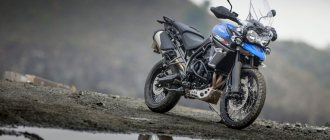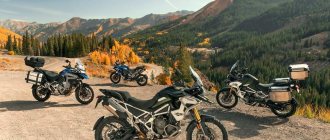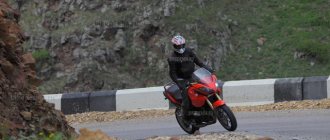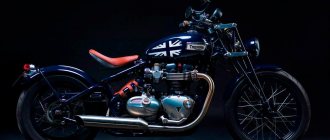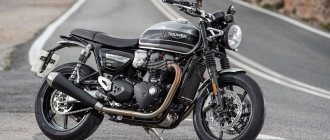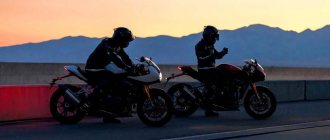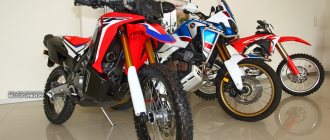Finally, the British have officially presented the updated line of their touring enduro Triumph Tiger 900 2022. The new motorcycles will be available in four versions - GT, GT Pro, Rally and Rally Pro.
All of them will differ from each other in filling, but they will all receive the same braking system with 320 mm front brake discs and the best civilian monoblocks for today, Brembo Stylema.
The most important update of the Triumph Tiger 900 2022 was the increase in the displacement of the in-line three to 888 cm³, which gave an increase in both power and torque. The inline three now generates 95.2 horsepower at 8,750 rpm. and 87 Nm of torque, which are now available at 750 rpm. earlier, namely at 7,250 rpm.
This should have a good effect both off-road and during everyday use, because the previous generation engine was quite high-powered, and it clearly lacked power in the lower and middle speed range.
Triumph Tiger 900 Rally Pro and GT Pro 2022
As a former Triumph Tiger 800 XCx owner and big touring bike enthusiast, I was very interested in the new model. Triumph is positioning the new Tigers this way: GT - for primarily road driving, and Rally - for those who often encounter cross-roads, that is, replacing the incomprehensible letters XR and XC with more familiar nomenclatures. The new products are supposedly created almost from scratch, better in all aspects than the previous Tiger 800, and I wanted to find out how much the marketers' statements coincide with reality. I had the opportunity to test both the Tiger 900 GT Pro and the Rally Pro to see what's changed and how those changes affect the ride, on and off road.
Engine
It's clear from the press materials that Triumph has put a lot of work into the new product, but that work is even more highlighted by the new 888cc engine, which feels, sounds and performs completely differently. At the same time, the main service intervals remained unchanged: 9,600 km between oil changes and 19,200 km between checking/adjusting valve clearances.
What's new? Firstly, the crankshaft. The previous engine had a conventional 1-2-3 firing order, but the new T-crankshaft, as Triumph calls it, uses a 1-3-2 firing order, with the first and third cylinder firing almost simultaneously, and the second after a longer pause .
This makes the engine really different, and probably more interesting. It pulls more powerfully, though not as readily as the Yamaha triples. It revs quickly and smoothly and allows you to ride comfortably between 2500 and 7000 rpm. I kept an eye on the tachometer, because judging by my feelings and experience with the previous engine, it seemed to me that the needle should be higher.
Torque increased to 88 Nm at 7250, but power remained the same and there - 95 horses at 8750 rpm. I absolutely commend Triumph for this. Instead of stupidly increasing the displacement to add a few horses at the top, they changed the character of the engine and made it more flexible and controllable just where most riders needed it.
I think the clear thread that will run through this entire review is that Triumph listened to the owners of the Tiger 800 and did everything as they were asked. And an excellent example of this thesis will be the location of the airbox.
To get to the filter on the previous model, it was necessary to remove the sides of the radiator, the sides of the tank and finally the tank itself, then the airbox becomes accessible. You need to unscrew a handful of screws in it, and there you have it, a filter. The whole ritual took at least an hour, and this is provided that you are a skilled craftsman and are in your favorite garage.
The new filter is simply located under the seat. Four bolts holding the lower sides of the tank, and six self-tapping screws securing the cartridge filter. The entire process takes 10 minutes from start to finish. For those to whom the difference is not obvious, I’ll explain: off-road, the filter resource is consumed much faster. When driving in dusty areas, you will need to check it or shake it out (unless of course you use a reusable filter, which I strongly recommend) after each ride.
Chassis
One of the main complaints about the previous Tiger 800 was that they made the passenger footrests non-removable. They were welded to the subframe, which was in turn welded to the frame. And there were two problems with this.
Firstly , for many, these off-road footpegs simply made it difficult to move weight on the bike. And it was impossible to remove them.
Secondly , with such a design, it is very easy to damage the frame in a fall off-road. The Internet was full of sad stories from Tiger owners who bent the passenger footrest and were forced to change the frame (using the warranty with varying degrees of success). The Tiger 800 was perhaps the only modern touring bike with such wild design.
On the 2022 Triumph Tiger 900, the rear aluminum subframe is removable , with four attachment points to the new steel cage frame. The passenger footrests are also removable, which provides much greater freedom of movement during off-road driving.
True, there were some complaints here: the quality and processing of the welds is much worse than you expect from Triumph. And the size of the plugs for the fastenings of the passenger footrests is smaller than the diameter of the fastenings themselves. It looks kind of collective farm.
There are a few discrepancies in the materials provided by Triumph, but it seems that the weight of the new Triumph Tiger 900 is 7 kg less than the previous 800. But more importantly, it feels even lighter thanks to its weight distribution.
The engine now sits 20mm lower in the frame, and moved forward 40mm when measured from the center of the crankshaft. And it is also tilted forward by about 6 degrees. It is easy to notice that the radiator at the front of the bike now has a split design due to this. Due to the fact that the new engine requires less oil, they reduced the oil pan, and therefore the ground clearance even increased, despite the lower position of the engine in the frame.
Brakes and wheels
The new Triumph Tiger brakes using four-piston Brembo Stylema, which replaced the previous Nissin. The size of the discs increased from 305 to 320 mm, and the master cylinder became radial. The rear brake is a single-piston Brembo on a 255mm disc.
The front brake lever is adjustable over a wide range, so its position can be adjusted perfectly to your own hand. Braking has become much clearer and more powerful compared to before. The initial grip is strong and the lever is nicely responsive and progressive.
A big plus for off-road enthusiasts is that the rear brake pedal on the Rally and Rally Pro is the same as on the Scrambler 1200. It has two different positions, so it is easier to press and has a clearer feel in the rack.
The base Triumph Tiger, GT and GT Pro are equipped with alloy wheels, like the previous Tiger 800 XR range. The front wheel is wearing 100/90R19, and the rear wheel is wearing 150/70R17.
The Triumph Tiger 900 Rally and Rally Pro have spoked wheels and tubeless rims, a nice feature not available on the previous Triumph Tiger XC. This means that you can now take with you a repair kit or a can of foam for tubeless tires, unless of course you drive on asphalt. For those who prefer off-roading, it is still recommended to install a tube and ride at reduced pressure, and you know why this is so if you have ever tried to fit a tubeless tube on a bent rim. So tubeless rims are great because they expand the range of options available, but that doesn’t mean you should take every opportunity thoughtlessly.
It's strange that the more aggressive stock tires aren't available for the Rally and Rally Pro. All new Triumph Tiger 900s come with Bridgestone Battlax Adventure A41 asphalt. On our off-road outing we drove a Pirelli Scorpion Rally, which is quite good on asphalt and much better than stock off-road. Triumph should have supplied the Rally Pro with these tires, or at least given a choice of two options at no extra cost.
Pendants
WP suspensions, known to us from the XC variants, have given way to Showa customizable ones on the new Triumph Tiger 900 Rally and Rally Pro. The 45th fork has adjustments for smoothing compression, rebound and spring preload. The rear shock absorber is adjustable for preload using a remote adjuster and for rebound smoothing using a screw.
Suspension travel on the Rally version has been increased to 240 mm at the front and 230 mm at the rear. These are very respectable values for off-road-oriented versions of the tourenduro (only the KTM 790 Adventure R has 10 mm more rear suspension travel).
The base version, Triumph Tiger GT and GT Pro are equipped with Marzocchi suspension. The fork is also 45, inverted and without adjustments in the basic version. The GT and GT Pro feature compression and rebound adjustment, a first for the more road-going Tiger variant. The fork travel is the same - 180 mm.
The rear suspension has manual preload adjustment in the basic version. The GT additionally comes with rebound smoothing adjustment, while the GT Pro has electronic preload and rebound adjustment. The travel of the rear shock absorbers of all versions is 170 mm.
Electronics
The top-of-the-line variants, the GT Pro and Rally Pro, come equipped with all the electronic options available on those models. These are the bikes we were given for testing, and this is what they have on them.
As mentioned above, the GT Pro's rear shock is adjusted electronically, specifically through the new 7-inch TFT panel (which is only available on the Pro versions). The preload has four stages and the rebound damping has nine stages, providing degrees of comfort from soft to sporty. Preload is individually adjustable, and smoothing settings can be changed in one of two ways. Each of the ride modes has a preset smoothing value, but this can be changed manually if the situation calls for it at some point.
The Triumph Tiger GT Pro has five riding modes: Road, Sport, Rain, Off-Road and Custom. The latter allows you to configure everything you want to configure and remember the set values. It's important to note that there's no way to disable ABS here: that capability is reserved for the sixth riding mode, Off-Road Pro, which is only available on Rally Pro. I think it's a shame on Triumph's part to make this mode only available on the Rally Pro, since GT Pro or base Rally owners also need to tweak all the available options. It's a shame to pay extra for Rally Pro just to be able to turn off ABS and traction control on an off-road bike. But more about this later.
Each riding mode affects throttle response, ABS intervention, traction control, tilt ABS and tilt traction control, the latter two provided by Continental's new inertia measuring device. Of the five options, only the basic Tiger 900 does not have this device.
The top two variants also feature heated grips, heated seats on both sides, tire pressure monitoring and Triumph's Shift Assist Pro quickshifter for clutchless upshifts and downshifts. A new version of the Triumph MyApp is also available, through which the navigator on the phone can suggest turns on the motorcycle's dashboard. We tested the beta version - and it had a couple of bugs, but that's why it's beta. I wonder how much better the release version will be, because the functionality is nice.
There are four different styles available for the dash, but none of them include a highly visible tachometer. What is there is difficult to distinguish, and driving without the ability to monitor the speed is somehow not for me. The navigation on the dashboard is also a bit lackluster: I've used previous versions of Triumph's digital instrument cluster, so I got used to the navigation quite quickly. But a couple of my colleagues without similar experience could hardly find the functions they needed. So I recommend that Triumph Tiger 900 owners take the time to study the dashboard before driving.
Verdict
It should come as no surprise that the 2020 Triumph Tiger 900 lineup does not deviate from its intended and established place in the market. It's not trying to compete with KTM for the most worthy off-road adventure bike, nor is it trying to be a good budget option to take on the Yamaha Tenere 700. The whole Tiger 900 has proven itself to be a fantastic tech choice for comfortable touring, without giving up anything from big adventure bikes. What has always been interesting to me about Triumph motorcycles is that they have English DNA built into them. British engineers, designers and staff are put into these bikes for their intended purpose. In England, as a generalization, people don't take adventure bikes to the extremes that some others do, and this is evident with the Tiger 900's place on the market. A fantastic touring bike with more than enough guts to take on the muddy, muddy Welsh trails if the rider is up to it, one that can carry you home comfortably with a toasty bum and warm hands.
What Triumph has done with the new Tiger 900 range is take an engine that was once a great proposition between the Inline Four and Twin, and push it further towards the Twin's signature power delivery without losing its torquey nature. This is especially useful in rally modes because this change is welcome and appreciated off-road. The 2022 Triumph Tiger 900 is an engineering feat that the people at Hinckley should be proud of, with the goals achieved in the new engine and chassis, and since they told us this was the company's biggest press release yet, I guess they're a little.
Source motorcycle.com
Road test
We started on the asphalt, leaving on Saturday morning and reaching the final point of the route in the evening. The first thing I noticed when riding the Triumph Tiger 900 was the difference between the engine and the 800. I liked it much more than its predecessor. The thrust develops much faster and more powerful. Low and medium speeds are quite working. And the sound and feel are simply impressive, and the only drawback is that around 6500 there is a slight vibration in the handlebars and seat, which does not subside until the cutoff is around 10,000. But this bike goes 140 in sixth without reaching those rpms, so it's not scary.
Our road passed along very average asphalt, covered with cracks and holes, gravel and sand. In general, ideal conditions for testing tourenduro suspensions. On asphalt, the Triumph Tiger Rally Pro suspensions felt soft, almost too soft. I immediately became curious how they would behave on the off-road portion of the test ride. However, I note that I did not adjust them, but rode at the factory settings.
After drinking some coffee, we swapped bikes: I rode the GT Pro, and the differences between the two versions were immediately apparent. With shorter travel suspension and smaller wheels, the GT Pro feels much more like a compact sport tourer with a comfortable, upright riding position. I adjusted the suspension through the dash, setting it to firmer sport settings, and it worked great.
The Triumph Tiger GT's seat height is more comfortable than the Rally's - it hasn't changed since the previous XR. Each model has two seat positions: GT Pro - 810 mm lower and 830 upper, and the Rally Pro has 850 and 870 mm, respectively. There is an optional lowered seat, which lowers the height by about 2cm, and there is also a GT version with “lowered suspension”.
The shortest rider in our team was a girl with a height of 166 cm, she stood with her feet in the lower seat position on the Triumph Tiger GT Pro and reached with the tips of her boots on the Rally Pro in the upper position. She says if she bought a Rally Pro, she would be fine with the lower position of the stock seat, but it's nice to have an even lower option.
In contrast to my 190, I stood confidently with both feet on the same Triumph Tiger Rally Pro in the top seat position. The tank has been redesigned relative to the Tiger 800, and on the 900 it is more convenient to reach the ground and ride in a rack. Overall, the entire Tiger 900 line has become much more comfortable and adjustable for riders of different sizes.
KTM has a lot to learn from these guys.
What3Words
What3Words is "a simple way to talk about location," says the company's website, and we agree. This is an intriguing new way to easily pinpoint your exact location rather than using a 16-character GPS coordinate. The creators of What3Words laid out a three-by-three-meter grid around the world and assigned each square a three-word “address” (ie: fill.count.soap is the company’s front door at the office). This amounts to 57 trillion square meters worldwide. What3Words is also available in 35 different languages. Currently used in the UK by emergency responders and tested by logistics companies, What3Words can be found in travel maps, books and even integrated into Mercedes cars. App accessibility is also available through Ford SYNC 3 and now through Triumph's My App, which we used during our trip.
A dedicated ride mode button on the left switchgear allows users to easily switch between modes that alter traction control, throttle mapping and ABS. The base model only offers Rain and Road modes, while the GT offers four: Rain, Road, Sport and Off-Road. The GT Pro gets a fifth mode, Rider, in which settings can be customized (ABS cannot be turned off completely). As you'd expect, from Rain to Sport, traction control is less intrusive as the throttle ramps up, while Off-Road maintains ABS on the front wheels, disengages the rear wheels and dials TC back to keep the rear wheels spinning.
Touring delights are most plentiful on the GT Pro with optional lighting, heated seats (driver and passenger), quick-change up and down shifter and tire pressure monitoring systems with Triumph's accessory catalog offering over 65 accessories.
Off-road test
The second day began with the beach, gradually turning into the desert. This time we were all riding Tiger 900 Rally Pros, shod with Scorpion Rally boots, with the center stands and passenger pegs removed. Personally, I have already torn off the central hub on an off-road bike, so I perfectly understand the meaning of such preparation.
On the second day my focus was on the chassis. The bike turned out to be much more balanced for off-road use. It's not even close to being as rough as the previous Tiger 800. It's stable and confident in sand and rocks.
The Triumph Tiger Rally Pro suspensions were tuned for us by a former Dakar racer named Alex. On my bike, the compression and rebound were set to 10 clicks (all the way out and 10 clicks in), and each chainstay was set to 20mm of preload (all the way out and 20 full turns). In the rear, the preload was set to the normal off-road setting according to the owner's manual, and the rebound screw was turned three-quarters of a turn from full.
I asked Alex about the suspension settings precisely because they worked flawlessly. A colleague and I agreed with our chaperone (an instructor at the Triumph off-road riding school) to let us do a little jumping on our bikes from a rock jump at the end of a long descent. We stated that this would help us “evaluate” the bikes - and the instructor, a man of the highest moral stability, made concessions to us. Despite some somewhat irresponsible jumping on the heavy bike, we only managed to break the suspension once all day. And when this happened, the impact was on the suspension stops, and not the engine protection on a rock, which distinguishes the new Triumph from the 800. It turns out that statements about improved ground clearance are also true.
I opted for the Off-Road Pro mode. In the regular Off-Road, some wheel slip is allowed before the traction control kicks in, but I found it overly warning and wanted the ability to really rip the rear wheel off in corners, on sand or loose gravel. And as I said, I think it’s an oversight on Triumph’s part to add an Off-Road Pro mode as part of Rally Pro. I don't need warm grips, extra safety features or a quickshifter, but I do need this mode to get the most out of this bike.
After spending almost an entire day without traction control, I was finally able to appreciate how well the new model grips the ground. And it's not just the tires: when I read the marketing opus in the Triumph brochure, where they talk about the new engine and how the updated crankshaft and firing order help the engine avoid stalling the rear wheel, I immediately decided that it was empty talk. I was wrong.
Climbing up a rather loose rocky slope, my friend and I looked at each other meaningfully. The old Tiger would instantly tear off the wheel here, but the new one digs in and clings. Engine response is greatly improved and the bike doesn't stall like the 800. I think it also has something to do with the slipping clutch.
Of all the improvements Triumph has made, the real disappointment has been the defense. I don't think the aluminum reinforced lever guards are super expensive, and I found the crankcase guard to be quite flimsy. I would have preferred the big, toothy rally footpegs found on the XCA because my feet kept slipping off the stock ones, especially after driving through streams. As for the arcs, I didn’t have a chance to test them.
